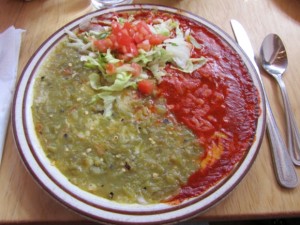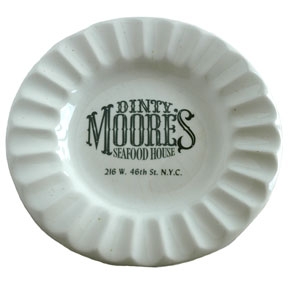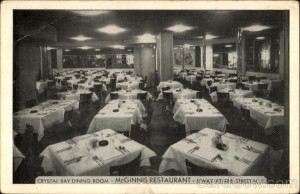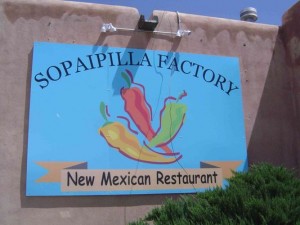Yes, it’s Christmas every day at Sopaipilla Factory, the exemplary comfort food restaurant dishing out New Mexican cuisine a 15-minute drive north of Santa Fe. HG lunches there at least twice a week. There’s a ritual. HG slides into a comfy booth. Felipe Garcia, the pleasant, welcoming proprietor, says: “Señor HG, enchilada or burrito? Christmas, as usual?” HG always orders chicken. An enchilada for light eating or a giant burrito when really hungry. “Christmas” has a specific meaning in Norte, the food language of Northern New Mexico. It means half the plate is smothered in green chile and half in red chile. Red and green. Christmas. Get it? At Sopaipilla Factory the red chile has plenty of heat while the green is mild and mellow. It is just the opposite at nearby El Parasol, another HG favorite. At Angelina’s in Espanola, the heat levels vary every day. Last time HG was there the waitperson warned HG about the green chile. “Picante !! Picante !!” HG tried it anyway. Mouth fire. So, when eating in Northern New Mexico ask about the heat levels of the two chiles but be sure to order “Christmas” if you want to have a tasty holiday.
Christmas Every Day
April 30th, 2014 § 0 comments § permalink
Pecan Bars At Panade: An SJ Posting
April 10th, 2014 § 1 comment § permalink
SJ Here. For the last two months I have been on a quest to change the meaning of my “S” to skinny. This has meant avoiding sugars, pasta, bread, starches, etc., like a truly modern (and unhappy) man. For the most part the temptations have been negligable (although I have been dreaming of steaming bowls of Pasta laden with anchovies and garlic) except for one: the Pecan Bars (dubbed Crack Bars by those in the know) served up at my local coffee spot, Panade. Panade is one of the great neighborhood spots — a fixture of North Chinatown / LES — with an owner, Yvette, who not only serves up great coffee, “puffs,” and sandwiches but is also a true emissary of our hood: everyone knows her, she knows everyone and thus the disparate worlds of Chinatown are melded in her small storefront. Every morning when I get my coffee a display of these Pecan Bars mocks me — they are the perfect baked good — nutty with pecan goodness, rife with the flavors of butter and toffee, moist and slightly chewy. Sweet, but not cloying. Nothing beats them as a mid-day treat (or mid-morning or mid-night or mid-dusk or in the mid of really anything) and they raise a mighty alarm to my will power every day that I force myself to go without. So, generous soul that I am, if I cannot have them I would like to entreat all you loyal Hungry Gerald readers to make a trip south of Delancey and try the vaunted Panade Pecan Bar — truly the best cookie in New York City.
Franny’s. Simple. Seasonal. Italian.
April 7th, 2014 § 0 comments § permalink
That’s the title of a wonderful cookbook, a Christmas gift from thoughtful SJ. Franny’s, of course, is the Brooklyn restaurant owned and run by Francine Stephens and Andrew Feinberg. HG dined there a few years ago. Best cured meats, salumi and pizza HG ever tasted. Franny’s has become a mini-empire and success has been based upon Stephens’ and Feinberg’s watchwords: Simple. Seasonal. Italian. The original Franny’s on Flatbush Avenue has moved to a larger space. The original space is now occupied by the couple’s trattoria, Marco’s. (They also operate a food market, Bklyn Larder). The Franny’s cookbook is beautifully written and illustrated, filled with appetizing ideas. HG/BSK cooked Franny’s version of penne with zucchini and mint a few days ago. (Hadn’t previously known how mint enhances zucchini). A beautiful dish when topped with a goodly splash of extra virgin Sicilian olive oil. Tomorrow HG/BSK will cook Franny’s paccheri with swordfish, olives, capers and mint. Paccheri is a tubular pasta (literal translation from the Italian is “a slap in the mouth”). HG/BSK will use rigatoni (easier to find).
Secret of A Good Paris Steak: Imported Meat
March 25th, 2014 § 0 comments § permalink
When HG wanted to get some vigorous jaw exercise in Paris, HG ordered a bavette (flank steak) or an onglet (hangar or butcher steak). Tough? These were broiled baseball mitts. Well, it seems times are changing and the outlook is rosy (or bleu or saignant) for the Paris steak eater. The French, supremely nationalistic about their cuisine, are finally making an admission: French beef can be admirable when long cooked as pot au feu or boeuf bourgignon. But, served as steak French beef is usually tough and tasteless when compared to imports from Germany, Scotland, Argentina and the United States. That’s why more than 20% of meat presently served in French restaurants is imported. And, that number is rising. Good Paris steakhouses like Le Severo and Au Boeuf Couronne now depend on imports. You can get a nice steak at those places (Severo’s frites are exemplary and Boeuf Couronne serves hard-to-find pommes souflee). But, if you want really great steak nothing beats a traditional New York eatery like Spark’s and Keen’s Chop House (yes, Peter Luger’s is good but a tad overrated). HG believes New York’s restaurateurs reserve the best cuts in the world for themselves.
Dinty Moore’s: Irish/Jewish and All Good
March 19th, 2014 § 4 comments § permalink
St, Patrick’s Day has come and gone and tons of nasty corned beef and cabbage have been consumed. Irish bacon and greens was the traditional holiday dish in Ireland. This got converted to corned beef and cabbage in the United States (HG doesn’t know when). Anyway, today’s inebriated Paddy’s Day revelers eat stringy corned beef (injected with lots of chemical tenderizer), limp cabbage and sadly overdone boiled potatoes. HG’s late Mom would comment: “Feh!!”. There was a time when corned beef and cabbage was a gourmand dish and it was served at Dinty Moore’s, an Irish restaurant on W. 46th Street in New York’s theater district. James “Dinty” Moore opened the restaurant in the 1920’s. Closed in the early 70’s. If Lindy’s and the Stork Club were identified with Walter Winchell, the powerful columnist and radio personality, Dinty Moore’s was identified with Louis Sobol of the Journal-American, the kindest and gentlest of the Broadway columnists. James Moore was the favorite restaurateur of the theatrical and sporting gentry because he defied Prohibition. He ignored it. It was always business as usual at Dinty Moore’s. Moore was often hauled into court but he paid his fines with a smile and kept serving good strong spirits. As the years rolled by, Moore recognized the fact that many of his customers were Jewish. He added gefilte fish (much better than HG’s Mom’s version) to the menu and the Irish lamb stew, beef stew and liver and onions were always made with kosher products. (The rasher of bacon that accompanied the liver and onions was decidedly non-kosher). Prices were high but were paid uncomplainingly because everything served was of the highest quality, plainly cooked and not disguised by intricate sauces. The signature dessert was rice pudding. It was sublime. It was a favorite of Jimmy Cannon, the eloquent sports columnist. A number of generations have grown up seeing Dinty Moore’s Beef Stew on supermarket shelves. No connection with the restaurant and HG doubts if it tastes anything like the wonderful New York food HG consumed at Dinty’s.
The Roast Beef Sandwiches Of Yesteryear
March 18th, 2014 § 1 comment § permalink
For many years the McGinnis Restaurant on New York’s Broadway (there was also a branch in the Sheepshead Bay neighborhood of Brooklyn) dispensed a lavish, rare roast beef sandwich. Its rival was The Brass Rail on nearby Seventh Avenue. The Brass Rail was adjacent to the Roxy movie palace (named after the showman “Roxy” Rothafel and demolished to make way for undistinguished office towers). The Brass Rail specialty was “The French Dip”. This was a roast beef sandwich on a mini-baguette dipped in a savory beef gravy. (Messy. But not as messy as the Chicago Beef Sandwich, a favorite in the Windy City). The best of all New York City roast beef sandwiches was served at Shine’s on 7th Avenue between 33rd and 34th Streets near Penn Station. There a stately African-American man in a chef’s hat carved slices behind a counter from a vast roast with surgical precision. On the more pedestrian side, HG liked the roast beef sandwiches served at many of New York’s old fashioned Jewish delicatessens in Brooklyn and the Lower East Side. A nice smear of chicken fat on seeded rye. Roast beef. Coarse salt. Black pepper. Sliced sweet onion. In the days when Harlem was a Jewish neighborhood, there was a Harlem delicatessen (name, alas, forgotten) that served the sandwich and attracted customers who had to patiently wait in a long line in order to enjoy the treat. The Chicago Beef and the Philadelphia Cheese Steak never caught on in New York. The New York attitude: “Why hide the flavors of delicious rare roast beef carved from a prime rib, corned beef, pastrami and brisket?” Why, indeed? HG/BSK had a delightful Saturday tradition after shopping at Bloomingdale’s.. HG/BSK would visit nearby Dover Delicatessen and pick up roast beef, ripe Liederkranz cheese, a sliced rye bread, potato salad, cole slaw. HG/BSK liked their roast beef sandwiches with Russian dressing. The cheese was showered with chopped onions and paprika. Much fun.
When The Great White Way Was Appetizing
March 17th, 2014 § 0 comments § permalink
There is a glittery expanse of Montparnasse in Paris that is filled with movie houses, creperies and four landmark restaurants. The super-pricey (and worth it) Le Dome which serves the best grilled sole in Paris (the fish swims in sublime lemony melted butter). La Rotonde which has fine oysters and steak tartare. Select (nice for a pre-dinner drink). La Coupole (beautiful art deco decor and fine oysters but everything else is miserable in this chain-operated trap for tourists). Montparnasse reminds HG of New York’s Broadway in its glory days (which ended in the 60’s). There were the big time movie houses: Paramount (where Frank Sinatra thrilled the bobby soxers); Capitol, Strand (all with stage shows in addition to first run movies)). Also Criterion, Trans-Lux, Palace, etc. Loads of good restaurants (mass and class) starting at 42nd Street and moving north into the 50’s where they gave way to auto showrooms. Here were some of them: Hector’s Cafeteria (good, cheap food); Rosoff’s (excellent roast duck); Turf (fine cheesecake); McGinnis’ (lavish roast beef sandwiches plus sea food specialties); Jack Dempsey’s (The champ served fine steaks). Just a few steps oiff Broadway was Gluckstern’s, a top flight Jewish kosher restaurant (not to be confused with the OTHER Gluckstern’s that was on Delancey St.). Also just off Broadway was Dinty Moore’s (best corned beef and cabbage plus liver with onions and bacon). The unquestioned essential Broadway restaurant was Lindy’s. Immortalized in Damon Runyon’s fiction. Comedians like Milton Berle, Jack E.Leonard, Jack Carter and Henny Youngman topped each other with one liners in its environs. It was where the powerful columnist Walter Winchell lunched. Song writers, bookmakers, gamblers, press agents, actors, producers, musicians and other colorful folk filled the tables. The food, which ranged from Jewish-American specialties to superb pork sausages with eggs, was splendid. And, the cheesecake was legendary (even better than Junior’s or Turf). What happened to the wonderful New York cuisine that Lindy’s exemplified? Gone. The world changes and not always for the better.
HG Heroine (and a Bit of Favoritism)
March 14th, 2014 § 0 comments § permalink
Senator Debbie Satenow, Democrat (of course) of Michigan, is an HG heroine. The farm bill President Obama signed last month increases subsidies to fruit and vegetable farmers and emphasizes aid to locally grown, organic, healthful foods. The New York Times reported Senator Satenow “negotiated, prodded, cajoled and finally shepherded the bill through Congress over two and a half years.” Many thanks, Senator. The celebrity chefs get a lot of exposure but it’s folks like you who make sure that good food is on America’s tables. Here’s a bit of joyous nepotism: Restaurateur Daughter Victoria and husband/chef Marc Meyer pioneered farm-to-table menus at their three New York Restaurants (Five Points, Cookshop, Hundred Acres). They were the first to advertise the farmers, ranchers and fish-mongers from which they procured the wonderful ingredients that made up their dishes. Wonderful cooking that lets natural flavors shine.
Sopaipilla Factory: Anything but a Factory
March 3rd, 2014 § 0 comments § permalink
A sopaipilla is an airy, crisp northern New Mexican treat much like a classic popover. Served with a ball of honey infused butter, they are addictive. As the name indicates, they are the specialty of Pojoaque’s Sopaipilla Factory, a very pleasant restaurant about a 15-minute drive north of Santa Fe. Despite an unfortunate name which brings to mind the dreaded Cheesecake Factory, this is not a tourist restaurant. The clientele is local (like HG)) but very diverse. Many tables of turbaned Sikhs (there are some nearby ashrams); multi-generation Latino families dining together; farmers, ranchers and artists. The food is classical New Mexican with a surprising number of healthy vegetarian options (including tofu fajitas). HG’s twice-a-week lunch is a chicken/cheese enchilada (HG requests that sides of rice and beans be eliminated). Here’s how the dish is composed: A very sizeable amount of shredded white meat chicken is rolled in a tortilla with white Mexican cheese melted on top. HG specifies “Christmas”. This means half the dish is covered with flavorful green chile sauce and the other half with fiery red. For crunch, HG showers it all with chopped sweet onions (There’s also a mini salad of shredded lettuce and chopped tomatoes). If HG is really hungry, HG orders the giant chicken burrito or the chicken stuffed sopaipilla (both adorned “Christmas” style). The restaurant also offers a suave bowl of tender menudo. A full bar with a nice array of tequilas and margaritas. HG sometimes has a “Michelada”, a beer and Clamato juice drink in a salt rimmed glass with lime edges. The drink gets a substantial shake of Tabasco. It’s a local favorite as is everything about this delightful restaurant.
Pasta Joys
February 26th, 2014 § 0 comments § permalink
It may seem like HG is referencing the Middle Ages, but back in the 1970s pasta was still a fairly exotic term while spaghetti ruled the roost when it came to Italian noodles dishes. The great wave of wonderful pasta dishes and their sauces had yet to arrive in the typical american pantry. In fact, HG first tasted penne with broccoli at Delsomma, a wonderful (alas, long closed) Italian restaurant on W. 47th Street in New York. (HG wrote about the restaurant: Gone But Not Forgotten Restaurants: Delsomma…Sept. 2011). Loved the dish and it became a mainstay in the HG/BSK home. BSK makes the broccoli sauce this way: Blanches florets and stems in the boiling pasta water. Purees some of the broccoli in the blender with chicken stock. Sautes the rest of the broccoli in olive oil with anchovies and minced garlic. It’s all blended with parmesan and poured over the pasta with a dusting of red pepper flakes and chopped parsley. Mighty good. Giuliano Bugialli, the esteemed Italian pasta authority, suggests another way to make penne with broccoli, a method popular in southern Italy. The broccoli is cooked with the pasta. First, the stems are added to the boiling pasta. After two minutes, the florets go into the pot. in 12 to 15 minutes the pasta is al dente and the broccoli is cooked. Minced garlic, red pepper flakes and capers are heated in olive oil and poured over the broccoli and pasta. Showered with chopped parsley. HG will try this method but will add anchovies, an ingredient that complements the sponge-like nature of a broccoli floret.
While it may seem difficult to find a new method to making pasta, BSK did just that a few days ago: Cauliflower-bacon-penne risotto. That’s right. Risotto made with penne pasta instead of rice. BSK roasted cauliflower florets with a dusting of cumin. Fried thick cut bacon to crispness. Deglazed the bacon pan, sauteed some garlic and added the bacon and roasted cauliflower. Cooked the penne like Arborio rice. In a heavy saucepan, cooked sliced onion in olive oil until transparent. Mixed the softened onions with penne. Added chicken stock. Tossed in a tablespoon of dry white wine. Brought liquid to a boil. Reduced to medium high and then simmered. HG stirred the mixture until the penne had absorbed the flavorful broth and was al dente. HG made sure some starchy broth remained to make a sauce. In went the cauliflower-bacon with Romano cheese, Maldon Smoked Sea Salt Flakes and ground pepper. A perfect dish wish a green salad and red wine. Pasta still has many joys.









